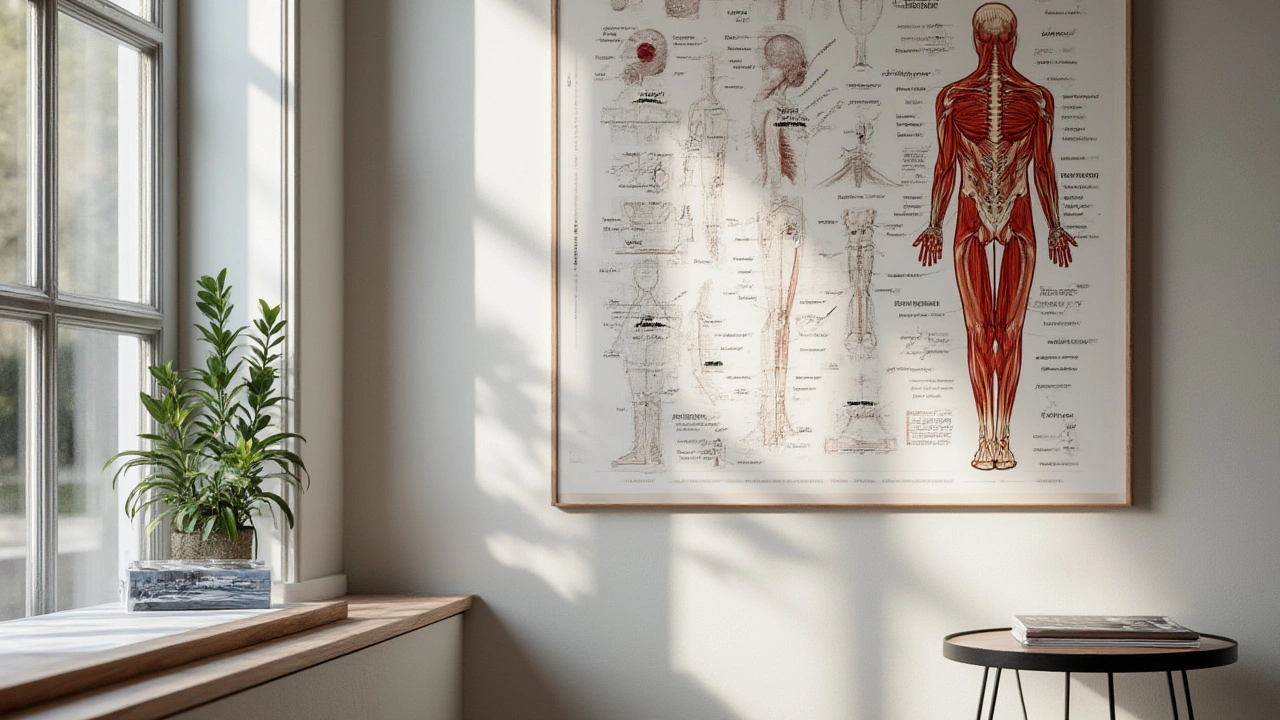Discover the transformative potential of deep tissue massage with this comprehensive guide. Explore how this therapeutic technique targets deep layers of muscle and connective tissue, offering relief for chronic pain and stress. Learn about different styles available, what to expect during a session, and how to find the right therapist. We’ll also cover practical tips on safety and getting the best bang for your buck.

- Created by: Archer Caldwell
- Completed on: 15 Jul 2025
- Categories: Deep Tissue Massage
Ever feel like your back is tight enough to bounce a quarter off it? Or maybe your legs knot up after running for the bus—not exactly Olympic training, but it hurts all the same. Muscle knots don’t care if you’re a gym enthusiast, a desk jockey, or just someone who occasionally contorts into odd sleeping positions. They sneak up, stick around, and laugh at your foam roller attempts. But here’s the wild thing: Deep tissue massage isn’t just a luxury, it’s a genuine fix for those stubborn knots. Recent surveys in London show more people under 40 are booking deep tissue massages than ever before. Why? Because the aches aren’t going away on their own, and a proper rubdown is sometimes the only thing that works. Ever wondered what actually happens during a deep tissue massage? Stick around, because the science—and the experience—might surprise you.
Definition and Context: What Is Deep Tissue Massage and Why Should You Care?
So let’s break it down. Deep tissue massage is a special kind of massage therapy focused on reaching those muscles and connective tissues that love to hold onto knots. Unlike your basic spa rub (think Swedish massage, all gentle and floaty), deep tissue is all about pressure that gets where it hurts, in the best way. Therapists use slow, steady strokes and press down with fingers, thumbs, sometimes even elbows, aiming to get right into the stubborn bits most regular massages miss.
Why should you care about this? Well, muscle knots—or what therapists call myofascial trigger points—aren’t just random aches. They actually mess with your range of motion, zap your energy, and, if you let them stick around, they can even cause referred pain that feels like it’s coming from somewhere totally different. That’s why headaches can actually start in your shoulder and why back pain can make your leg tingle. Deep tissue massage digs into the root of these problems, sometimes literally, by breaking up those adhesions and coaxing muscles back to normal.
Now, here’s something most people don’t realize: A deep tissue session isn’t just about working harder, it’s about working smarter. Many therapists in London and around the world go through extra training to master this approach. There’s a sweet science behind how they chase down knots without leaving you feeling like you lost a fight. Experts say most muscle knots come from bad posture, overuse, injuries, or stress—ever catch yourself holding your shoulders up near your ears on a deadline? That tension collects, and deep tissue massage is like a reset button, helping your body let go.
Fact: A 2023 study in the British Journal of Sports Medicine found that deep tissue massage reduced pain intensity in people with chronic muscle tightness by nearly 35% after just three sessions. That’s not just a luxury; that’s serious relief. What’s more, it works for people from all walks—athletes, writers, chefs, even the guy who carries his dog three flights of stairs every day (ask Isabella—she’s got stories!).
Benefits of Deep Tissue Massage: Real-World Results and Surprising Perks
So, what do you actually get out of all this muscle digging? The benefits are more than just feeling loosey-goosey for a few hours. Number one is pain relief. That’s the big one—say goodbye to waking up with locked shoulders or dragging through the day with a burning lower back. Deep tissue massage doesn’t mask the pain—it attacks the source, calming inflamed spots and smoothing out tense bundles of muscle.
You also get a better range of motion. Think of it like oiling a rusty hinge. When those knots go, you can move without feeling like a robot short-circuiting. People who jog, dance, swim, or just try to keep up with kids notice this right away. My running buddy swears by deep tissue massage—he says it’s the reason he shaved two minutes off his 5K last year.
Here’s something cool researchers have found: Deep tissue massage appears to lower your levels of cortisol (the stress hormone) and increases feel-good hormones like serotonin and oxytocin. It’s not just in your head, either—2022 data from a London wellness center said 67% of regular clients noticed they slept better after sessions. That’s a real bonus when the city noise never shuts up.
But the magic doesn't stop with your muscles. Regular deep tissue work can actually help prevent injuries by keeping muscle fibers aligned and flexible. It’s like getting maintenance done on your car before things break down—proactive, not just reactive. Plenty of pro athletes book these massages as part of their recovery plan after intense workouts or games. Some even use deep tissue massage as part of their warm-up routine, so their bodies are limber and ready to perform.
And sure, let’s not forget the feel-good factor. There’s something deeply satisfying about handing over your aches and pains to someone who knows exactly how to untangle them. If you’ve ever had a therapist find that mystery knot you didn’t even know you had, you know how addictive that relief can be.
Types of Deep Tissue Massage Available in London
London is loaded with options when it comes to deep tissue massage. You can find therapists who stick to classic techniques, digging deep with hand and finger pressure, or those who use tools like massage guns or heated stones to work even deeper into the tissue. Some clinics combine deep tissue with other approaches—like sports massage, where the focus is on performance and injury recovery, or trigger point therapy, which zeroes in on specific knots to release pain fast.
Then there’s the modern twist: Places offering deep tissue with stretches (kind of like assisted yoga) or blending in myofascial release for serious chronic issues. Certain wellness studios even add aromatherapy or gentle oils for those who need the extra comfort, especially if a tough session leaves you feeling a bit sore (totally normal, by the way; that’s your body saying, “Hey, something happened here!”).
You’ll see plenty of massage therapists qualified in both deep tissue and sports massage—especially around Central London, where many gyms and fitness centers are located. Some clinics near parks or popular running routes tailor their sessions for runners and cyclists, using special techniques for tight calves, hamstrings, and glutes. There are even mobile therapists who’ll show up at your door after a long workday, table in tow, ready to untangle whatever the city has knotted up.
Swedish and deep tissue can overlap, but the main difference is pressure and focus. For example, Isabella prefers when the therapist explains everything before they start, asking which areas need the most attention—your experience is much more tailored than just a “one size fits all” rub. Also, some spots in London have male and female therapists so you can request based on comfort, and others let you add extras like hot stone therapy or CBD lotions for extra recovery.
How to Find Deep Tissue Massage Services in London
Here’s the trick—finding the right therapist is a bit like online dating. Not every match is perfect, but when you find the right fit, you’ll know. Start with reviews. Websites like Treatwell, Google Maps, or even local Facebook groups are packed with honest feedback about which places actually work magic, which ones talk a good game but can’t back it up, and where the bonus perks are (some offer free herbal tea or aftercare tips, which is always a win).
Location matters, too. Many of the best-rated deep tissue massage spots are clustered near busy areas like Oxford Street, Liverpool Street Station, and Notting Hill. If you want a quieter vibe, look for independent clinics a bit further out—sometimes you get better value, and it’s easier to book last-minute appointments. Some therapists work from home studios, which can feel more personal and private than glitzy chains.
Certifications are worth checking—look for therapists who have proper training, accredited by bodies like the Federation of Holistic Therapists or the Complementary and Natural Healthcare Council. You want someone who understands anatomy, not just someone who can press hard enough to leave a mark. By the way, deep tissue isn’t about bruises—if you feel genuine pain during your session, say something! Quality therapists always adjust pressure to fit your needs, and you should never leave limping (unless, of course, you want to brag about surviving the “toughest massage in London” on Instagram).
Lots of spas now have booking apps or instant messaging for quicker appointments. Handy tip: Many therapists offer off-peak pricing if you’re flexible with your timings—think late mornings or early afternoons, when the rush slows down. And if your office has wellness perks, check if deep tissue massage is covered; some London companies now pay part or all of the cost to keep their staff loose in more ways than one.

What to Expect During a Session
First off, dress comfy. Most therapists will ask you to strip down to your underwear, then cover you with a towel or blanket. Modesty’s respected—only the area being worked on gets uncovered. Therapists usually check in before starting, asking if there are specific knots or pain spots you want sorted. Good communication matters here—mention anything that doesn’t feel right.
The session kicks off with some lighter strokes to warm up your muscles, then shifts to deeper pressure. Sometimes, a therapist will use knuckles, elbows, or forearms to get right into those stubborn knots, working slowly to let your body relax and allow tension to release. You might feel a hint of pain, but it should be what pros call “good pain”—sort of like a stretch that’s a little tough, but ultimately a relief. It’s not unusual to feel a bit raw or sore for a day or two after, especially if it’s your first deep tissue experience or you’ve been tight for ages.
Breathing helps, a lot. If you tense up or hold your breath when someone digs into a knot, everything gets harder. Try to take slow, deep breaths—even hum a bit if it helps distract from the intensity. Some therapists play low-key music or white noise to help you chill.
After your session, drink water—seriously, your body has been shifting around old tension and flushing out stuff it’s held onto. Hydrating helps recovery and can prevent that post-massage “hangover” feeling. Some offices hand out herbal tea or stretching guides to keep things loose for longer.
One weird side effect: People sometimes get emotional during or after deep tissue sessions. That’s your body letting go of stress, not just physical tension. If you need a good cry (or laugh), go for it—it’s surprisingly normal, and most therapists have seen it all.
Pricing and Booking: What Does a Deep Tissue Massage Cost, and How Do You Book?
London isn’t the cheapest city, but deep tissue massage pricing can actually be pretty reasonable, especially if you shop around. On average, expect to pay £55–£90 for an hour-long session at a reputable clinic, but rates might climb in trendy neighborhoods or if you want an at-home visit. Some high-end studios ask £120+, especially if they include perks like aromatherapy or post-massage snacks.
You can often save money with block bookings—buy five sessions, get the sixth free, that sort of thing. Some places offer student discounts, weekday specials, or loyalty rewards. Watch for package deals around holidays; Valentine’s Day, Father’s Day, or wellness awareness months can prompt some sweet bargains.
Booking is mostly digital these days. Big spas and chains have direct online scheduling or mobile apps. Independent therapists might prefer WhatsApp, text, or classic phone calls. Last-minute or lunchtime appointments tend to get snapped up fast in the city center. If you’re particular about your therapist’s gender or want a quieter slot, book ahead—some of the most popular pros are booked out weeks in advance.
Double-check cancellation policies when you book; flexibility varies, and some spots ask for 24-hour notice to avoid fees. Pro tip: If you plan to go regularly, ask about subscriptions or monthly payment plans—it’s like a gym membership for your muscles.
Safety Tips: How to Stay Safe and Get the Best Experience
Here’s the golden rule: Speak up. If pressure is too much—don’t just grit your teeth and push through. A good therapist wants feedback, and it helps them tailor the experience so you actually heal, not hurt. Always mention medical conditions, recent injuries, or medications that affect your blood flow (like blood thinners) before your session starts.
Make sure your massage therapist is properly qualified. Most reputable spots in London can show you certificates or credentials on request. If a therapist seems sketchy or doesn’t ask about your health, skip them—you deserve better.
It’s a good idea to eat a light meal about an hour before your massage. Heavy meals can leave you feeling sluggish, while an empty stomach can make you lightheaded. After your session, avoid intense workouts for a day—your body needs recovery time, and jumping right into spin class can undo all the good work.
If you’re pregnant, elderly, or have health conditions like severe osteoporosis, deep tissue might not be right for you—or it might need serious modification. When in doubt, get your doctor’s okay first. Oh, and if you’re worried about hygiene (it’s London, after all), check for clean, fresh linens and general tidiness when you arrive.
Comparison Table: Deep Tissue Massage vs. Sports Massage in London
| Feature | Deep Tissue Massage | Sports Massage |
|---|---|---|
| Focus | Chronic muscle tension, knots, and overall body tightness | Injury prevention, athletic performance, muscle recovery |
| Techniques | Slow, deep pressure on muscle layers; myofascial release | Deep pressure, stretching, joint mobilization, event-based routines |
| Best for | Desk workers, anyone with chronic pain, people under ongoing stress | Athletes, gym-goers, runners, anyone training regularly |
| Typical Cost (1 hr) | £55–£90 | £60–£100 (can be higher for specialized sports clinics) |
| Aftercare | Hydrate, stretch, rest sore muscles | Hydrate, gentle movement, sometimes ice/heat therapy |

FAQ: Your Questions About Deep Tissue Massage Answered
- How often should I get a deep tissue massage? Most people do well with monthly sessions, but if you have chronic pain or are training hard, every 2-3 weeks might be ideal.
- Does deep tissue massage hurt? You’ll feel pressure and maybe some “good pain,” but you should never feel tortured. Tell your therapist if it’s too much.
- Can I combine deep tissue with other therapies? Absolutely—lots of London centers offer combo sessions with hot stones, aromatherapy, or even acupuncture.
- Is deep tissue massage safe for everyone? It’s great for most people, but check with your healthcare provider if you have major health issues.
- Should I tip my therapist in London? Tipping isn’t always expected but is super appreciated if you loved your session—10% is a nice gesture.
- Can I work out after getting a massage? Wait at least 24 hours to let your body recover and get the most benefit.
- What’s the difference between deep tissue and Swedish massage? Deep tissue goes beyond the surface, using stronger pressure to dig into knots, while Swedish is lighter and more about full relaxation.
Ready to finally tell those knots who’s boss? Book a deep tissue massage in London today—you might just find your new favorite way to beat the aches, stress, and muscle tightness of city life.
Explore the most effective body massage types-from Swedish to deep tissue, Thai, hot stone, and sports massage. Learn how each works, who it’s for, and how to choose the right one for your needs.
Discover how deep tissue massage can be an effective tool for improving mental health. This article delves into the ways massage therapy reduces stress, anxiety, and depression, offering readers practical tips on finding qualified therapists and understanding what to expect during a session. Explore various types available in Bristol and learn about the safety measures to ensure a beneficial experience.



